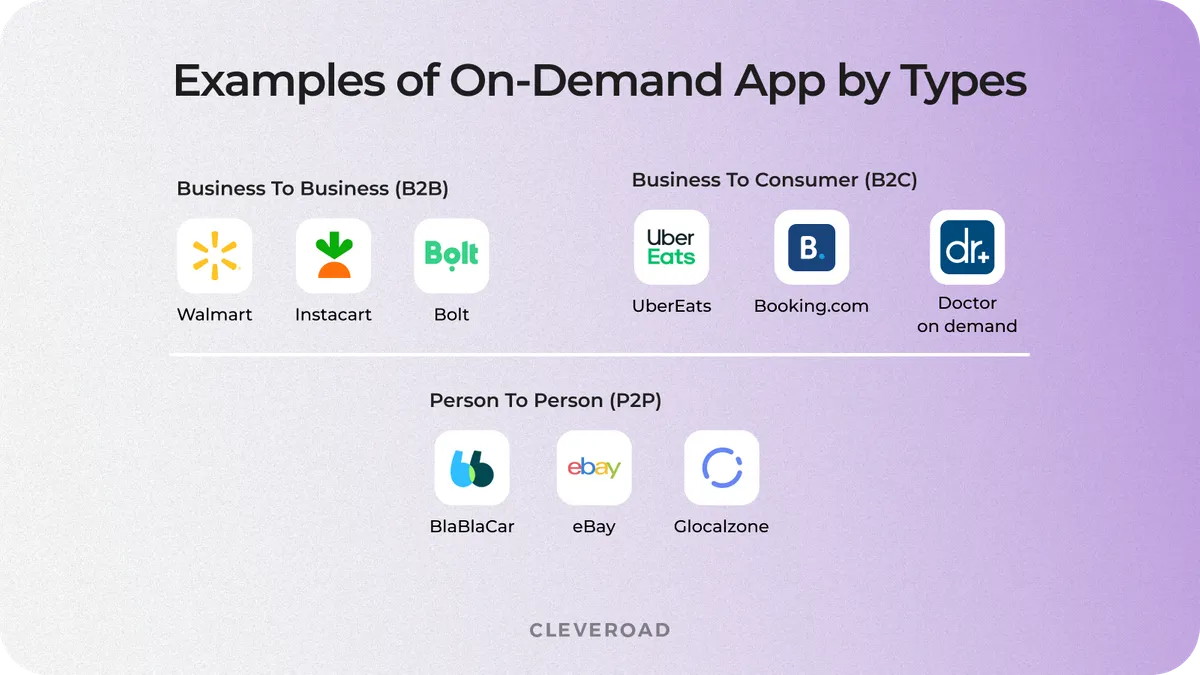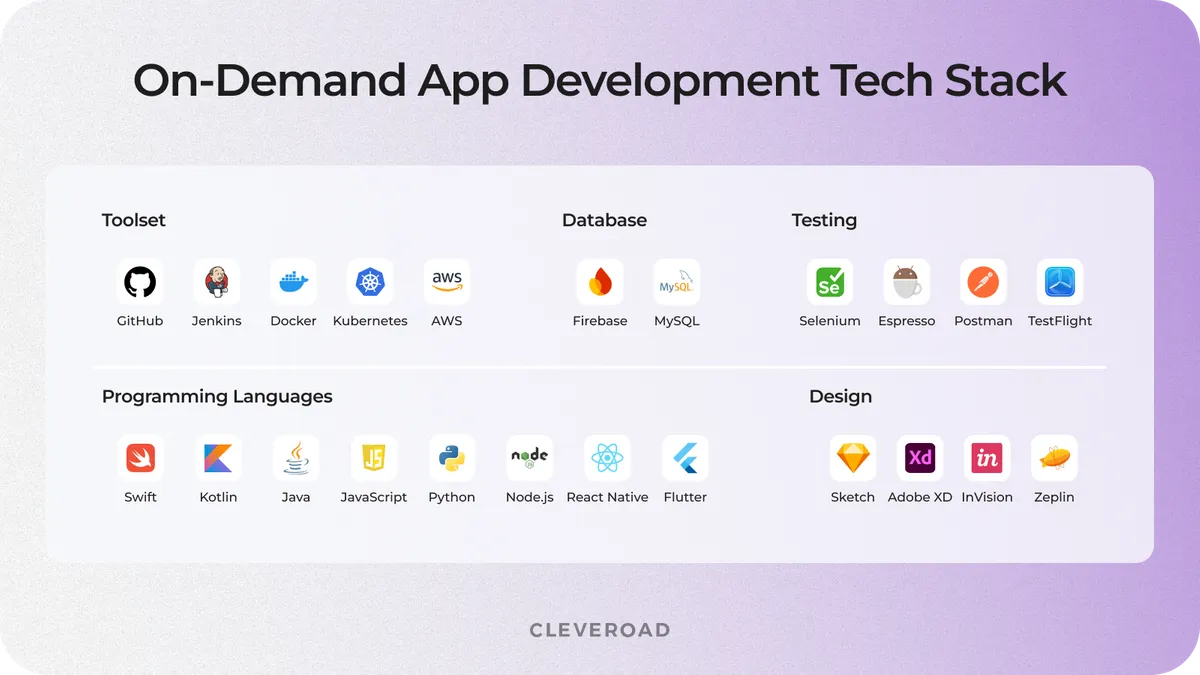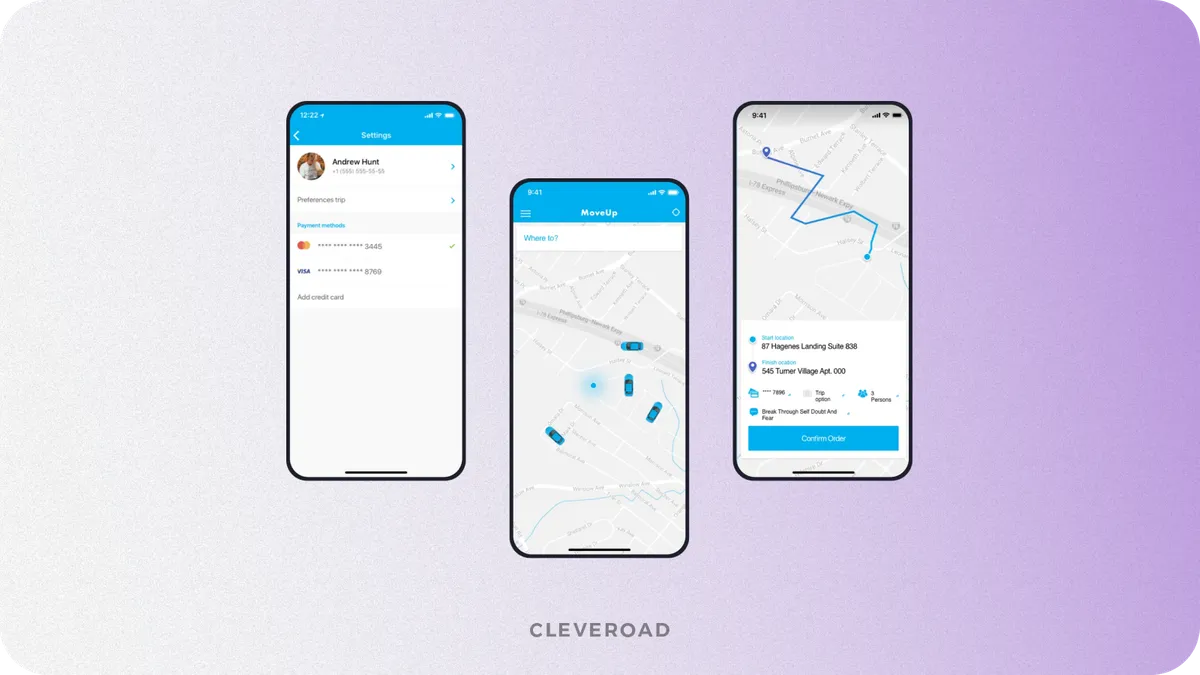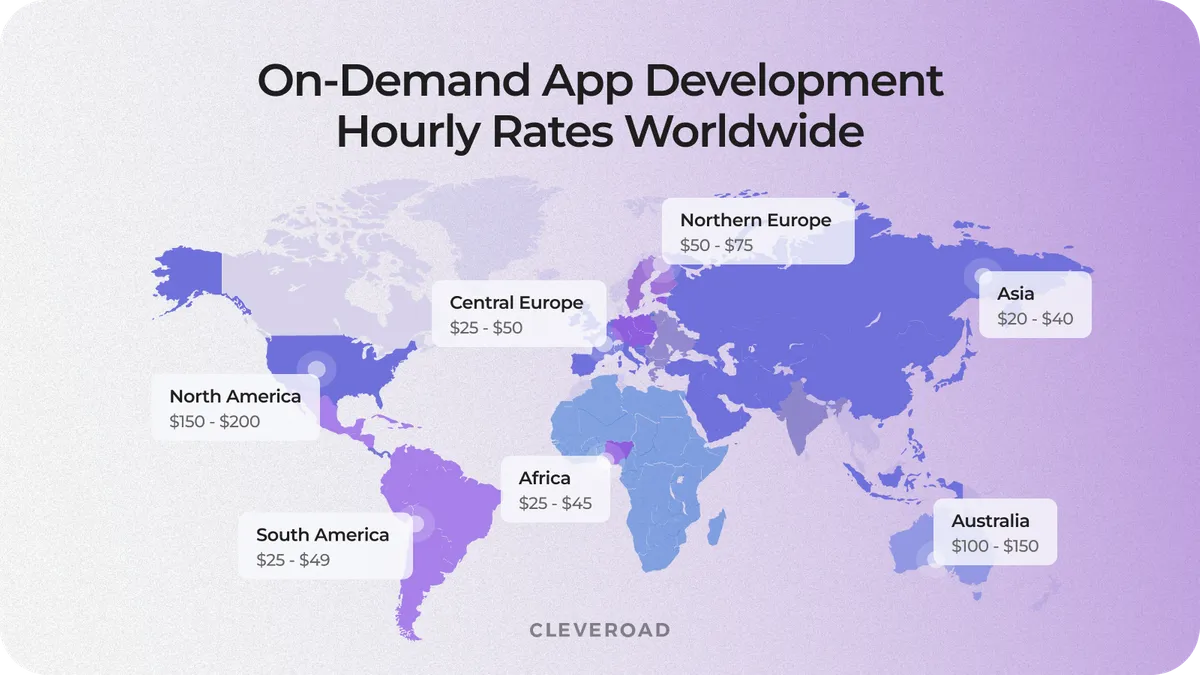On-Demand App Development: Full Overview for 2025
Updated 11 Oct 2024
19 Min
11427 Views
On-demand service apps are everywhere – we can hardly imagine a field unknown to on-demand market. The variety of services, speed, convenience, and quality make these apps popular and widely used around the globe. But behind everything, there's a fast, reliable, and easy-to-use platform.
In this on-demand app development guide, you’ll learn about on demand service app development aspects, from types of software to must-have features. You’ll also learn how to build an on demand app to make the most out of it.
How to Build an On-Demand App: Steps Breakdown
Follow these steps to find out how to make an on-demand app:
- Step 1. Select a niche and analyze your target audience.
- Step 2. Find an experienced team to build on-demand app
- Step 3. Collect the project’s requirements and define a feature set.
- Step 4. Develop your minimum viable product (MVP on-demand app) to gather initial feedback.
- Step 5. Choose a monetization strategy.
- Step 6. Test the product and launch it to the first customers
- Step 7. Develop a fully-featured on-demand platform
- Step 8. Track your key metrics and promote your on-demand mobile app to acquire more users.
All these stages of on-demand app development have their peculiarities and winning strategies. The number of steps can vary depending on your goals and project requirements. So keep reading, and we'll discuss them one by one.
What Is an On-Demand Service App?
On-demand delivery application works as a mediator between a customer and a business. Just like Uber does for cabs, Airbnb for hotels and Zomato for food delivery. The on-demand platform allows users to order any kind of service and strives to deliver it in minutes, like booking a ride through Uber. These apps solve users' major and minor everyday problems. For now, there are on-demand platforms in beauty, education, healthcare, taxi and cargo delivery, food delivery, and many other fields. And we can get all that beauty just by a few finger taps.
On-demand services app connects customers with different service providers, and vice versa. Of course, the platform charges a fee for that. But users from both sides often prefer paying extra money over spending hours searching for the right specialist/customer. Thus, on-demand apps offer a faster and more convenient procedure and make their few dollars in return.
Here’s how on-demand apps like Uber work:
- User places a request.
- App connects them with a service provider.
- Provider checks the request and accepts it.
- Payment is authorized.
- Provider delivers the service.
- Customer confirms the delivery.
- Payment is deducted.
According to Burson-Marsteller’s survey, 42% of adult Americans have used at least one of on-demand app services. And the number is only growing.
There are a few reasons for such popularity:
Lower costs
On-demand mobile application development offer lower prices, compared to traditional providers. And cost's often the main driver for buyers.
Availability
Smartphones and tablets are everywhere, so any service with a reliable mobile platform is handy, accessible, and one-click easy to get.
Adjustment to preferences
On-demand businesses know what their users want, and they aim to deliver services as fast as possible. For instance, within 2-3 hours, not days.
Various payment methods
Mostly, on-demand apps use Stripe or Braintree payment gateways or e-wallets like PayPal. Besides, on-demand delivery apps accept cash as well.
Minimum efforts
There’s an option to save your details like payment info, delivery address, and so on. No need to enter this information again and again with each new order.
Variety
Tens of apps in each category, from babysitting to make-up service, meaning each user can find a solution that works best for them.
What Is the potential of on demand app development
On demand service app development is gaining popularity in the Post-Covid world, and this trend continues to grow. On-demand mobile applications provide customers with One Click service. According to Medium report, the on-demand app economy is going to reach $335 billion by 2025. So, let’s see why to build on demand app is a profitable idea:
- The total market car-sharing/car rental is expected to reach $304.97 billion by 2025, with a CAGR of 23%
- More than 80 million Americans have already used on-demand services.
- Uber’s delivery segment reached revenue of $3.2 billion and grew by 4% in Q1 2024
- More than 63% of consumers order online to avoid long lines and crowded parking lots.
The success stories of Uber, Glovo, Airbnb, and TaskRabbit have pushed the on-demand economy forward, stimulating phenomenal growth. The global situation and increasing consumer bias towards such digital solutions indicate the right time to create an on demand app.
Types of On-Demand Service Apps
While planning on how to build an on demand app, it’s vital to define what kind of solution you want to deliver. This will determine the targets and feature set of your future application.
Based on the users involved, on-demand apps can be divided into three groups:
- Business-to-Business (B2B) on-demand application development
- Business-to-Consumer (B2C) on-demand app development
- Person-to-Person (P2P) on demand application development
Business to business
Business-to-business on-demand service applications connect one enterprise to another. They involve providers, suppliers, Maintenance Company, etc. Like B2C customers, B2B clients expect high levels of customer satisfaction, and on demand mobile app development is an excellent way to deliver a seamless experience. For instance, Walmart’s suppliers employ a group of mobile applications that are linked to Walmart’s supply chain platform. Statista estimated that the European B2B e-commerce market value will be worth 1.8 trillion by 2025, so creating an on demand app of this type is promising.
Business to consumer
Enterprises tend to think on how to create an on demand app to distribute their goods or services. The user only needs to download the app to find the required services or order products. These can be applications that cater to single providers (e.g., specific restaurants) or multiple providers distributing their services (products) on a single platform. For example, the Starbucks app enables users to jump the line by ordering and paying for coffee in advance or having their order delivered right to the office. PR Newswire predicted that the global B2C e-commerce market will reach $7,724.8 billion by 2025, so by deciding to build an on demand app, you have considerable opportunities to make money fast.
Person to person
P2P on-demand service app development allow your users to exchange goods or services and make transactions through a specialized platform. For example, BlaBlaCar helps users to seek co-travelers. Users can offer or find rides online by entering trip details, such as points of departure, arrival dates, etc. Once the user seeks the perfect ride, they can book a seat, and the contact info is sent to drivers for further clarification. Another good example is the Glocalzone. The platform connects travelers with people aiming to purchase goods from a different country. It allows travelers to earn extra money while reducing the costs of importing hard-to-find products for a buyer.

Examples of on-demand application by types
On Demand App Development Across the Industries
As you can see, there are quite a lot spheres on-demand services come suitable for. Taxi, meal delivery, dog walking, babysitting, laundry pick-up – on-demand applications seem to be taking care of everything. So let’s see how various industries make the use of on demand service app development and consider leading apps in each.
Taxi services
The taxi and transportation field benefits from on-demand service apps the most. No wonder big players like Uber or Lyft have changed the game forever. Now, the taxi apps let customers book a car just in a few minutes. All they have to do is set their destination and wait for the cab to arrive. The driver will get a ride request and, if everything's arranged, come to pick their passengers.
Today's on-demand taxi apps offer many new features but the must-haves are:
- Map and GPS navigation that helps customers catch nearby taxis
- Communication channels between riders and drivers
- Advanced feedback system (rates and reviews)
The most well-known taxi apps apart of Uber and Lyft are:
- Flywheel
- Curb
- Free Now
By the way, we've also worked on a P2P on-demand app called MoveUp. It’s a taxi service just like Uber or Lyft, but targeted both at regular people who need a ride and at those with specific medical needs, bulky items, parents with children, etc.
We've created a brand-new on-demand ridesharing app with a sophisticated filtering system and offline driver's validation. Moreover, the app also includes complex payment capabilities with a free-ride option, allowing our customers to stay apart from the overused Uber business model.
As a result, our client received a scalable and flexible platform with integrated GPS technology, Stripe, and other features that helps people find the best transport option meeting their needs.
- Feel free to examine our MoveUp case study in more detail
Here’s what our client, John Salmon, founder at Unified Potential, Inc.dba MoveUP says about about cooperation with Cleveroad:
John Salmon, founder at Unified Potential, Inc.dba MoveUP says about about cooperation with Cleveroad.
Household chores
House cleaning, repairs, dog walking and many other everyday tasks take lots of time. And for those who need help with household chores on-demand apps is a perfect way out.
For example, if you got a leakage issue at home, you just post a request on the app and nearby plumber fixes it in no time. These platforms help with fixing carpentry problems, home appliances, etc.
Apps that have gained popularity in this niche include:
- TaskRabbit
- Merry Maids
- Thumbtack
Food delivery
Using a food on-demand delivery platform, users order meals from nearby eateries after checking the menus. As soon as the customer places an order, the restaurant starts preparing the dish and indicates when the food will be ready. By that time, the courier reaches the eatery, picks the food up and delivers it to the listed address.
The key food delivery apps’ success is speed and ease of use. An on-demand app development is a win-win solution for both customers and restaurant owners. Users can easily order food from hundreds of places by checking menus in the app. Owners get more orders and, thus, more revenue.
The best on-demand delivery platforms in the field are:
- UberEats
- GrubHub
- Instacart
- Doordash
Learn how to build an app like Uber Eats in our detailed guide exploring features, cost, and tools
Gifts & flowers delivery
Forgot about friend's or relative's birthday or just happen to be in other city? On-demand delivery app development regarding delivery come to the rescue again. As for now, the delivery of gifts and flowers is one of the solutions to enter the market and gain customers. Apps attract users because of:
- Wide choice of available products;
- Abilities to choose the delivery time;
- Doorstep delivery.
Today, the leaders in this field are:
- UrbanStems
- Gyft
- Giftagram
Healthcare
On-demand medical apps connect patients with doctors. So users can talk to their physicians one-on-one when they need help. And just like during an ordinary visit, doctors make recommendations.
Of course, no on-demand mhealth app can take care of serious disease, and patients can’t get tested or properly examined without going to a hospital. But a plain consultation is something on-demand service apps can cope with.
The best healthcare apps are:
- Doctor on Demand
- Pager
Learn about all aspects of doctor on-demand app development process, features, cost, and more
Logistics
Logistical on demand service app development have increased in popularity due to cross-border e-commerce activities and millions of diversified goods that should be handled properly to ensure a good delivery experience. Such applications bridge the gap between shippers and carriers. It enables users to track the goods in real-time, compare the carrier rates, scan the goods to collect item-related data, get electronic proof of delivery, receive instant confirmed bookings, and much more. The on-demand logistics market is anticipated to reach $75 billion by 2030, so it's better to build an on demand app of this type now to gain a competitive advantage.
The most prominent examples of on-demand platforms in the field are:
- Uber Freight
- Onfleet
How to Build an On Demand App in 5 steps
Now, let’s discuss how to make an on demand app in more detail. As an on demand mobile app development company, we’ll discuss the appropriate steps you should take to design a client-centric product.
Step 1. Do a research
It's a big mistake when investors care only about tech aspects (coding) and forget about the idea during on-demand app development. After all, coding just guarantees that the app will run smoothly. But it's the customer research that helps with finding the target audience, their pains and problems. Besides, the research helps with building apps that bring friendly experience to users.
Here are the main research tips:
- Learn about customers. Online behaviors, hobbies, pains and needs – the more you know about future users, the more attractive app you can build.
- Concentrate on unique functions. On the market this saturated, the best and often the only way to attract customers is to offer an original solution. No one wants to download on-demand delivery app clones with same features.
- Don't try to please everyone. Even if you do, the app won't be capable of solving all users' issues. Focus on the majority. Continuous updates aimed to serve all needs cost a lot – and there's no guaranteed profit returns.
Step 2. Pick the features
Before finding an app developer, you should clearly understand the project’s requirements. Thus, you need to prepare a list of features you would like to add. Oftenly, the client comes to an IT vendor with a request like “I want an Uber-like app”. But it’s better not just to build an Uber clone, but implement some unique functionality. The set of features will differ depending on the type of on-demand app.
Still, there are some features that just can’t be skipped:
- Registration
- Geolocation (or tracking)
- Notifications
- Payment
(Look for more details about features in the next section).
Additionally, you should think of how to monetize your on-demand platform. For instance, if you’re planning to create a food delivery website, you can get revenue from restaurant fees, user fees, advertising, etc.
Step 3. Find the right tech partner
When everything’s planned and arranged, it’s time to start looking for on-demand app development experts. Currently, there are two popular options – in-house or outsourced development:
- In-house teams – great for a long-term projects that need 24/7 support and maintenance, but often very expensive (you’ll have to cover insurance, taxes, salaries, vacation, sick days).
- Offshore developers – great for both short and long term projects, cost-effective (you can pay exactly for the work done), and outsourcing teams are ready to sign the contract to protect both parties.
Need tech partner to build an on-demand app?
Our experts, with over 12 years in the IT field, will help you create a comprehensive on-demand app that will become a reliable digital solution and a stable source of income for your business
Step 4. Choose the technology stack
On-demand mobile app development services require lots of technologies, depending on the selection of platforms. In fact, choosing a platform to build an app for is the most important part as it directly relates to customers' media experience. Thus, you'd better launch the app on platforms that are popular among your target users and keep close attention to tech details.
Here’s the example of technology stack our engineers usually use for on demand app development:
Mobile:
- iOS: Swift
- Android: Kotlin
- Cross-platform: React Native, Flutter
Web architecture:
- Front-end: React.js., Next.js., Vue.js.
- Back-end: Node.js., Python, Django, Ruby on Rails
Third-party integrations
- Payment processing: Stripe, PayPal
- Messaging and notifications: Twilio, Firebase Cloud Messaging
- Geolocation services: Google Maps API, Mapbox
- Cloud hosting and infrastructure: AWS, Microsoft Azure
- User authentication: Auth0, Firebase Authentication

On-demand app development tech stack
Step 5. Go through development process
Building an MVP is the best option if you’re still unsure of your product’s success or just want to launch the app as soon as possible. This way, you can validate your on-demand app idea and a short time to market with minimum investments. The core idea behind the MVP is to create an on-demand app with basic features to attract early adopters and collect initial feedback. There is no complicated framework implementation. Then, after testing your product on a real audience, you can reinvest in creating a fully-featured on-demand platform.
Essential Features to Implement in On-Demand App
Before contacting on-demand app development company, it’s always better to create a list of features you’d like to see. But first you should define how many parties are going to use the platform.
For example, if you're making a taxi, beauty or household service app, two parties are involved – customers and service providers. And, as business owners must have full control over both parties, an admin panel is another need.
But when it comes to food delivery, there's another party involved – the restaurant which prepares the meal. Check our full guide on how to build food delivery app for details.
So let’s check what features an on-demand services app can’t be viable without – on all sides.
Customer app
This is the user-facing app where customers can browse services, place orders, make payments, and track deliveries. It’s designed for a smooth user experience. This app usually include features like:
- Registration & profile management. Most apps allow signing in via email/phone & password combination or Google, Twitter or Facebook accounts.
- Geolocation. Works for tracking the delivery or finding the direction. Depending on the platform, geolocation can be either implemented on Google’s Location APIs (for Android devices) platform or Core Location framework (for iOS devices).
- Notifications. Inform users about completed requests, payments, order updates, and so on. SMS notifications work for reaching out to customers/providers when their phones go offline.
- Payments. Payment methods are added according to customers' preferences and country of residence – you'll need to do a research before adding PayPal, Dwolla or China UnionPay.
- Feedback system. By adding this feature to build on demand app helps customers to evaluate their experience with the company in the form of rates and reviews.
- Help & support. Feature assists customers in case of any queries. It enhances customer service by solving their problems and works for the company's reputation.

Interface of on-demand application for customer developed by Cleveroad
Service provider app
This app is used by businesses or individuals offering services (e.g., restaurants, salons, drivers) to manage orders, update availability, and communicate with customers. This app include the following features:
- Registration & profile management. Just like clients, service providers should be able to sign in using various registration options.
- Push notifications. They alert providers when a customer selects their product or service.
- Accept & reject buttons. They allow service providers to accept or decline requests within a given period of time if something doesn’t work for them.
- ‘My earnings’ page. Service providers make money via the on-demand services app, so they must have a feature that tracks their earnings.
- Online/offline button. If the service provider is ready to take orders, they go online in the system. But when their working day's over, and they decide not to go for another service, all to do is just toggle the offline button.
Administration app
This is the admin’s control panel for managing the platform, monitoring activity, handling payments, and ensuring smooth operations across both customers and service providers. Administration app usually include such features:
- Admin dashboard. A customizable dashboard should be easy to navigate while monitoring both customers and service providers.
- User management. Administrators receive access to information like users’ payments, charges for canceled orders, discounts, and so on.
- Service provider management. Admins check their performance and rates, and motivate them to work better with bonuses or sanctions.
- Change prices and fees. Via the admin panel, managers change the rates or set – higher or lower – commission charges.
- Analytics & reporting. Shows how many orders are accepted, canceled and repeated, and if the business is doing well in general.
Delivery agent app (if applicable)
This app is used by delivery personnel to accept, track, and fulfill orders, providing real-time updates to customers and service providers. Delivery agent apps incorporate features like:
- Profile & authentication. Secure login and profile management for delivery agents to ensure only authorized access.
- Order management. View, accept, or reject delivery requests with detailed order information for optimized workflow.
- Real-time navigation. GPS integration provides efficient routes, reducing delivery times and avoiding traffic.
- Status updates. Easily update delivery status (e.g., “picked up,” “on the way,” “delivered”) to keep customers informed.
- In-App communication. Built-in chat or call features to directly contact customers or support for clarifications.
- Earnings & analytics. Track earnings, payouts, and delivery performance in real-time for better work management.
- Notifications. Push notifications for new orders, updates, or urgent changes to keep agents informed.
- Proof of delivery. Collect customer signatures or photos as proof of successful delivery.
Cost to Build On Demand App
On demand app development cost ranges from $30,000 to $250,000+. The number of features and their complexity are the main cost drivers to create an on demand app.
Simple on demand applications
These are applications with a basic set of functionality so it’s a good way of developing MVP products. Simple apps have a primitive user interface and are generally designed for one platform. The cost to build on demand app of this type ranges from $30,000 to $120,000.
Medium-complexity on-demand applications
Pro-level on-demand apps are more challenging to develop. It includes more sophisticated functionality (for example, in-app chat, payment gateway integrations) and has a custom UI design. The price to create an on demand app of this type starts from $120,000 and can reach $200,000.
Complex on-demand application
Custom on-demand apps come up with high-level advanced features (e.g., advanced search, BI tools) and well-thought-out UI. They’re primarily built for profit-making and optimizing regular business processes. The cost to build an on demand app varies from $200,000 to $300,000, and more.
Let's summarize the cost to create on demand app:
- Simple on-demand apps - $30,000-$120,000
- Medium-complexity on-demand apps - $120,000-$200,000
- Complex on-demand apps - $200,000-$300,000+
Note: These numbers are approximate. The final price will depend on the project’s specificities, including platform, features, and 3rd party integrations.
Additionally, the cost of your on-demand project will also depend upon software developers’ rates. Average IT consulting fees per hour differ from country to country, ranging from $100-250 per hour in the USA and Canada, to $25-45 per hour in India and Pakistan.
Central and Northern Europe seems to be a golden mean charging $50-75 hourly while ensuring a high level of competency. For example, you can outsource mobile app development to Estonia to get lower rates and high developer qualifications. This country has third place in Central and North Europe for the number of IT workers, accounting for 300,000 specialists. In Estonia, IT is the largest export service industry. The cost-effectiveness is proven by global business: 20% of world-known tech companies have offices in Estonia. 110+ R&D centers owned by or working with global corporations, including Microsoft, SAP, Acronis, Parallels, and more.

Cost to build on demand app in different countries
On Demand App Development Services from Cleveroad
Cleveroad is a professional web and mobile development company with 12+ years of experience in offering custom on-demand software development services that power business processes and increase investment value. We have an extensive experience and deep knowledge of providing top-notch IT assistance for business 9 domains, including Healthcare, Logistics, Education, FinTech, E-commerce, etc.
By cooperating with us, you’ll ensured with the following benefits:
- A broad scope of on-demand IT services: creating apps from scratch, app modernization, cloud migration, cross-platform app development, UI/UX design, IT consulting, etc.
- Cooperation with a trusted IT partner certified with ISO/IEC 27001:2013 for security management and ISO 9001:2015 for quality management.
- Flexible approaches to IT service delivery: IT staff augmentation and dedicated development team.
- A team of technical experts that constantly develop their competencies in advanced technologies, such as IoT, big data, machine learning, AI, blockchain, AR, DevOps/Continuous Delivery (CD), etc.
- A robust Project Managementg Office (PMO) ensures streamlined project management, reducing risks and improving outcomes when partnering with Cleveroad.
To demonstrate our expertise in practice, here’s our latest on-demand project — Ayio – A platform to book custom services.
The AYIO app simplifies users’ lives by enabling them to quickly find and hire specialists in various fields for repair and other services. The primary challenge was creating an intuitive platform that allowed seamless switching between customer and vendor roles while delivering a high-quality user experience. Cleveroad’s on-demand app development service addressed these challenges, providing a functional, user-friendly MVP with an attractive UI/UX, all within the client's budget. The result is a high-performing on-demand service app that meets the customer's needs efficiently.
Build an on-demand app with our experts
Cooperate with an ISO-certified IT company that prioritizes robust quality and security management to receive top-tier on-demand application development service
On-demand delivery software works as a mediator between a customer and a business. Just like Uber does for cabs, Airbnb for hotels, and Zomato for food delivery. The on-demand platform allows users to order any kind of service and strives to deliver it in minutes, like booking a ride through Uber. These apps solve users' major and minor everyday problems. For now, there are on-demand platforms in home service, education, healthcare, taxi and cargo delivery, delivery service, food delivery, and many other fields. And we can get all that beauty just by a few finger taps.
Let's summarize the cost to create on demand app:
- Simple on-demand apps - $30,000-$120,000
- Medium-complexity on-demand apps - $120,000-$200,000
- Complex on-demand apps - $200,000-$300,000+
To build an on-demand service app, follow these steps:
- Step 1. Do a research
- Step 2. Pick the feature
- Step 3. Find the right tech partner
- Step 4. Choose the technology stack
- Step 5. Go through development process
The cost to create an on-demand app ranges from $30,000 to $250,000+. The number of features and their complexity are the main cost drivers for on-demand app developers when delivering on-demand app development services. The type of project, such as on-demand food delivery app development, can also influence the final pricing. The more advanced the on-demand solution or type of service, the higher the cost.

Evgeniy Altynpara is a CTO and member of the Forbes Councils’ community of tech professionals. He is an expert in software development and technological entrepreneurship and has 10+years of experience in digital transformation consulting in Healthcare, FinTech, Supply Chain and Logistics
Give us your impressions about this article
Give us your impressions about this article
Comments
7 commentsPerfect Blog!! I totally agreed importance of on demand app has increased it gives your business online present on the internet, but i think oil & gas industry also need on demand. but on demand development totally changed everything you can book everything on the phone just by clicking.
It is a very interesting blog and your pics are beautiful.

Thanks!
According to Harvard Business Reports, “the on-demand economy is attracting more than 22.4 million consumers annually in $57.6 billion spending. All these on demand services include freelance services, home services, transportation, food & grocery, health services, and other similar services”. With each passing day, the On-demand App Industry is reaching new heights. This rapid expansion can be seen everywhere. Almost everything from booking movie tickets, taxi, or ordering food, medicines, groceries, and much more can be done easily through on-demand apps. Hence, it is clear now that the on-demand industry has a bright future and isn’t going anywhere.
nice!
Perfect blog! I was searching for this blog. Thanks to Google to make me land here, all information is good and looking to share it with others. After 2019 we are seeing a boom in the on-demand app industry. One thing really impressed me which is some college students are investing in this industry to start a business and making money.
Very nice article got to know many new things
The fast-moving world demands services on the go. Uber revolutionized the market at a more rapid rate than expected. Multiservices services are on-demand and are becoming an instant hit wherever launched. Apps like Uber for X have brought varied services to our doorstep. People find it affordable and convenient for doorstep services.
At present on-demand application has become a compulsory element to the business to attract the customers. This article helps to understand the factors we have to consider while developing on-demand mobile app. The factors they have mentioned in this blog is important.